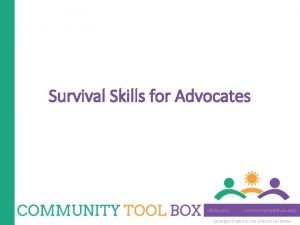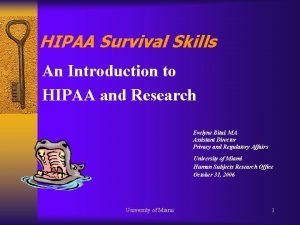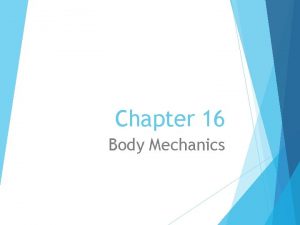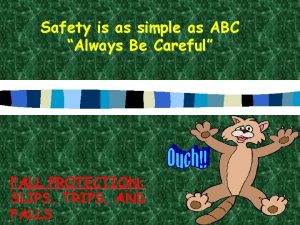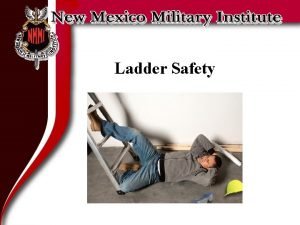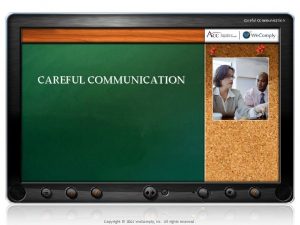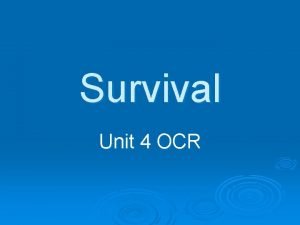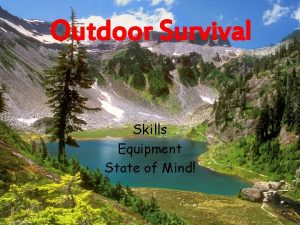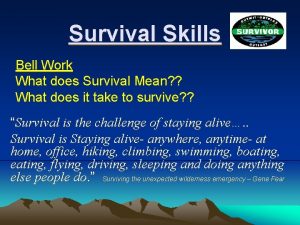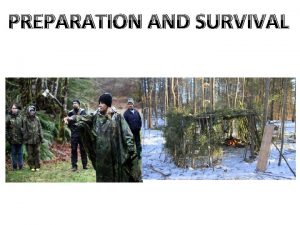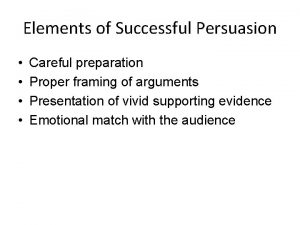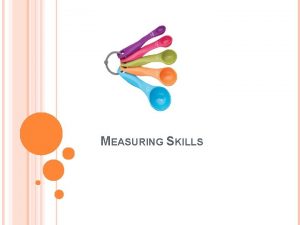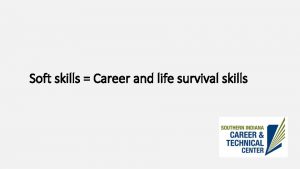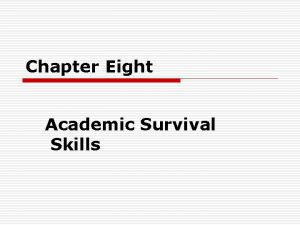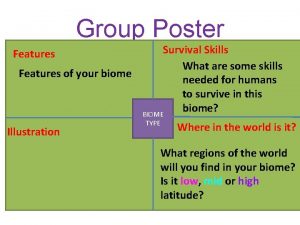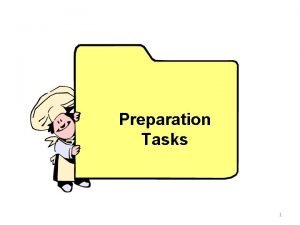Preparation and Survival Preparation and Survival Skills Careful
































- Slides: 32

Preparation and Survival

Preparation and Survival Skills � Careful preparation and the development of survival skills will allow you to endure most situations. � Remember to plan your hunt, then hunt your plan!

Clothing � Bring extra clothing � Pack rain gear � Layer if it is cold � Bottom layer: Wicks away moisture � Next layer: Thicker and insulating � Outer layer: Barrier from wind and water

Hunter Orange � Easily seen in nature � Signals to other hunters � Required in some states

Directional Aids � Maps � GPS

Maps � Topographical maps can be helpful � Contour lines reveal changes in elevation � Lines � Reveal that are close together indicate steep inclines direction of true north

GPS � Global Positioning System � Receives info from satellites to calculate position

When you are lost: � How you react will determine the outcome � Remember to S. T. O. P.

S. T. O. P. � Stop – Admit that you are lost � Think – Stay calm & think clearly � Observe – area & conditions around you. Look for shelter, fuel, water, & food. � Plan – Take inventory of supplies. Determine how you will use them best.

Rule of 3 � You � 3 can live: minutes without air � 3 hours without warmth � 3 days without water � 3 weeks without food

Stay Put! � Often the best choice! � Moving wastes energy and makes you harder to find! � Don’t cross fences. � Following a fence may lead you to a gate or road.

Signaling for Help � International emergency signal for distress: 3 evenly spaced shots from a firearm. � Using something reflective to catch the sun � Carry a Personal Locator Beacon

Emergency Shelter � Cave or Rock Overhang � Woodpiles or Brush � Made from Scratch

Floods � Be aware of changes in weather � Seek higher ground early � Never camp on low ground

Flooded Waterways � When � Find a waterway is beyond its normal banks: the best place to cross � Do not cross if it looks dangerous � Look for wide, shallow areas � Avoid the main current � Watch for floating debris � Crossing on a log or rocks can be dangerous!

If you fall or get swept away: � Float on your back with feet in front of you � Don’t try to stand in fast water � Use your hands to maneuver � Use your feet to push off objects

First Aid � Knowing the basics of First Aid and CPR will help you deal with emergencies

Hypothermia � The body loses heat faster than it can be produced or retained. � The core temperature can fall to a point the person will die. � Caused by: � Rain or snow � Immersion in water � Temperatures under 50 degrees

Hypothermia Symptoms � Early: � Shivering � Clumsiness � Slurred Speech � Stiff Fingers � Strange Behavior � Late: � Mental deterioration � Unconciousness

Hypothermia Treatment � Call 9 -1 -1 � While waiting: � Put victim in dry clothing or insulation � Apply heat *** � Do NOT burn skin with hot water � Give warm liquids if conscious

Frostbite � Freezing of a body part � Symptoms: � Lack of feeling in body part � Swelling � Discolored skin � Blisters

Frostbite Treatment � Remove victim from cold � Remove clothing from body part � Do NOT rub affected area � Place part in warm water (less than 105 degrees) � Wrap in dry, sterile dressing � NEVER warm a frostbitten area, if it might refreeze!

Heat-Related Emergencies � Heat Cramps � Heat Exhaustion � Heat Stroke

Heat Cramps � Least serious � Causes cramps in muscles � Due to loss of fluids & electrolytes � Treatment: � Move to a cool area � Drink cool liquids such as Gatorade

Heat Exhaustion � Serious � Indicated by cold, clammy skin and elevated temperature � Loss of consciousness � Treatment: � Move to cool area � Elevate head � Drink cool liquids like Gatorade in small amounts � Seek medical attention ASAP

Heat Stroke � Most serious � Symptoms: � Temperature of 105 or higher � Vomiting � Hot, dry skin � Confusion � Loss of consciousness � Treatment: � Call 9 -1 -1 � Immerse in cold water or ice soaked towels

If you discover an injured person: � Check area for danger � If unconscious & face down: roll face-up supporting head, neck, & back � Check respiration � Check vital signs � Check level of consciousness � Initiate a head to toe examination

External Bleeding � Place sterile gauze or clean cloth over it � Apply direct pressure � If bleeding doesn’t stop continue to apply more gauze pads � If limb: elevate above the heart � Use a tourniquet as last resort and never apply below elbow or knee.

Do NOT: � Use direct pressure on eye, embedded objects, or open fractures � Rinse wound with full strength medicines � Close wounds with tape � Breathe or blow on wound

Animal Bite � Very rare � Wash wound with soap and water � Apply pressure if bleeding � If animal was not provoked, consider rabies

Bee/Wasp Sting � Remove stinger � Wash with soap and water � Apply a cold pack for 15 -20 minutes � Relieve pain with aspirin � Apply cortisone cream � Be aware of possible allergies

Spider Bites � Two venomous Texas spiders: � Brown Recluse � Black Widow � Seek medical attention if bitten by one of these
 State of survival survival of the fittest tweak
State of survival survival of the fittest tweak State of survival survival of the fittest stages
State of survival survival of the fittest stages Survival skills for advocates
Survival skills for advocates Tony wagner's seven survival skills
Tony wagner's seven survival skills Survival skills introduction
Survival skills introduction Comparative well
Comparative well Using the body in an efficient and careful way
Using the body in an efficient and careful way Requires unbiased and careful questioning
Requires unbiased and careful questioning Emotions and moods
Emotions and moods Careful protection and preservation of environment
Careful protection and preservation of environment Intrapersonal and interpersonal communication
Intrapersonal and interpersonal communication Skills are
Skills are Why careful selection is important
Why careful selection is important Be careful lest you fall
Be careful lest you fall Scripture take heed lest you fall
Scripture take heed lest you fall Safety is simple as abc
Safety is simple as abc Adverbs of manner in sentences
Adverbs of manner in sentences Flattering tongue meaning
Flattering tongue meaning Be careful little mouth what you say
Be careful little mouth what you say Most evil positive and comparative
Most evil positive and comparative Can could must
Can could must Forgetful comparative hali
Forgetful comparative hali Qualified comparative and superlative
Qualified comparative and superlative Large adjective comparative
Large adjective comparative Be careful then
Be careful then The monkey's paw be careful what you wish for
The monkey's paw be careful what you wish for Essay on nature
Essay on nature Themes about being careful
Themes about being careful Ladder safety
Ladder safety Be careful, it's a jungle out there.
Be careful, it's a jungle out there. Be careful punctuation
Be careful punctuation Making careful notes is essential for
Making careful notes is essential for Be careful with your thoughts
Be careful with your thoughts


